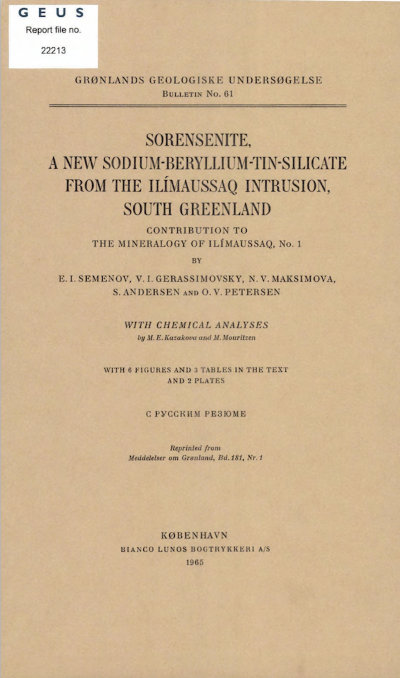Sorensenite, a new sodium-beryllium-tin-silicate from the Ilímaussaq intrusion, South Greenland
DOI:
https://doi.org/10.34194/bullggu.v61.6595Abstract
The new mineral sorensenite (Na4SnBe2Si6O16(OH) 4) occurs in groups of prisms attaining diameters of several centimetres. The mineral is transparent or semitransparent, colourless, brown or pink. The crystals are monoclinic, a0 = 18.58, b0 = 7.45 and C0 = 12.05, β = 98°09'. Space group C62h – I 2/a, C4s - Ia.
There are two distinct cleavages. The specific gravity is 2.9, the hardness 5-5.5. The mineral sometimes forms flat pseudohexagonal triplets with the normal to <011> in (100) as twin axes.
The mineral is biaxial negative, 2Vα ( = small to 75°, nα ( = 1.576-1.579, nβ = 1.581- 1.585 and nγ = 1.584 - 1.586. The chemical analysis (by M.E. Kazakova):
SiO2 49.73, SnO2 20.07, Nb2O5 0.75, Fe2O3 0.04, BeO 8.02, Na2O 15.95, K2O 0.34, H2O 5.24; total 100.14 corresponds to the formula: Na4SnBe2Si6O16(OH)4.
The mineral occurs in analcime-rich bodies in nepheline-sodalite-syenites of the llímaussaq massif, South Greenland. It is abundant in a few localities. Sorensenite is named after professor Henning Sørensen, Copenhagen, who directs the investigations in the Ilímaussaq region.
Downloads
Published
Issue
Section
License
This article is distributed under a CC-BY 4.0 licence, permitting free redistribution and reproduction for any purpose, even commercial, provided proper citation of the original work. Author(s) retain copyright over the article contents.


